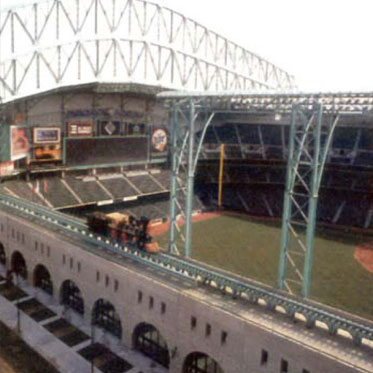In the same city where Astroturf made its debut, another material technology Wrings Houston a new baseball marvel.
When the Houston Astrodome, baseball’s first indoor stadium, opened in 1965, it had a natural grass field. The grass required a translucent roof, which produced glare and caused fielders to lose track of fly balls. To solve the problem, the stadium’s roof was painted and the grass replaced with the newly invented artificial surface that we now call Astroturf.
No matter what you think about baseball on artificial turf, it is commonly agreed that Houston was at the forefront of baseball stadium innovation in the ’60s. It continues that tradition today. The Astros still play ball under a roof but only when necessary. That’s because the city erected Enron Field, a stadium with a retractable roof that makes natural grass possible. Although Enron Field is not the first stadium with a retractable roof, it does boast a special suspension system that is engineered to open and close the roof without glitches.
Bart Riberich, vice president of engineering at Uni- Systems, the Minneapolis-based firm that designed the roof travel mechanism, says that operating problems occur when the suspension system relies on bogies. They concentrate the load at a single point when the wheels hit a high spot on the rail, thereby thwarting smooth movement. Instead of bogies, Uni-Systems engineers turned to independent suspensions for each of the 142 wheels that carry the three huge roof sections atop Enron Field. To make the independent suspensions work, the engineers needed a suspension spring that would compress when the wheels met a high spot on the rail.
Finding the materials to make the springs was about as easy as hitting a Randy Johnson fastball. Almost from the start, Uni-Systems eliminated conventional metal springs because they couldn’t achieve the targeted 25-year lifespan. The designers turned their attention to elastomers, which are not only highly resilient and durable but also able to handle heavy load capacity.
The Uni-Systems design team, along with engineers at Kastalon Polyurethane Products, Uni-Systems’ partner on the project, selected Adiprene urethane prepolymer from Uniroyal Chemical to make the springs. “The springs had to be compact to make the design work,” says Bruce DeMent, president of Kastalon. “The versatility of Adiprene urethanes allowed us to compound an elastomer that would give us the required performance.”
The patented cylindrical springs installed at Enron Field consist of alternating layers of steel and urethane around a central shaft. Only 8 in. in diameter and 9 in. tall, the assemblies support a normal load of 125,000 lbs and peak loads up to 325,000 lbs. Now, the Astros can play ball come rain or shine.
More information on polyurethanes is available by contacting Kastalon Inc. , 4100 W. 124th Place, Alsip, IL 60803 or calling (708) 389-2210.

